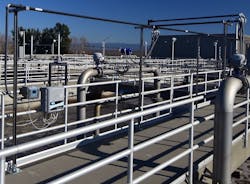Automatic Ammonia Control
Cost: $350,000
Location: City of Chico, California
Year: 2020-12-31
Size: 10,000 gpm
Owner: City of Chico
Designers: City of Chico
Ekster and Associates Inc.
Contractor: City of Chico
In 2018, the Chico Wastewater Treatment Plant replaced an existing inefficient dissolved oxygen (DO) control system with the model predictive control (MPC) based DO/Nmaster.
With a budget of $300,000, a small team of four looked at Chico, California’s WWTP to automate airflow control to the activated sludge process to achieve energy savings, consistent compliance with the National Pollutant Discharge Elimination System (NPDES) permit, and reduction of effluent total suspended solids to improve disinfection and reduction of total nitrogen.
The project was funded by the electrical utility based on ROI and by operational funds, which was a major challenge but not impossible for the team to navigate. To save costs, all hardware (15 electrical actuators, 15 DO meters, 15 flow meters, and three ammonia analyzers) were installed by one electrician and one operator. Within a short time the plant team purchased and installed dozens of instrumentation and control elements, connecting them to SCADA.
“The existing inefficient dissolved oxygen control (DO) algorithms were replaced with the commercial advanced DO and ammonia control system that utilizes historical data and machine learning in a combination with a model predictive control,” said Alex Ekster, co-owner of Ekster and Associates Inc. “Upon project completion the Chico plant became one of the very few plants in the world that operates a commercial artificial intelligence control system.”
Ekster and Associates Inc. designed a control strategy, and provided, commissioned and tuned the DO/Nmaster artificial intelligence control system.
Project implementation started after the plant team made a decision to move forward with the project almost immediately, instead of the traditionally one to five years between project initiation and implementation.
The results of the commercial advanced DO and ammonia control system operation showed that accurate (average accuracy 6%; median accuracy 4.5%, according to manufacturer data) air flow control was achieved using adaptive heuristic models.
Accurate air flow control was achieved using fast flow meters, regular actuators, and inexpensive butterfly valves. Accurate DO control was achieved in virtually all aeration zones while avoiding air flow oscillations.
Accurate ammonia control was achieved by utilizing feed-forward, feed-back control, and by maintaining a DO gradient within a predetermined range. Precise ammonia control allowed reduction of DO targets down to between 0.5 mg/L and 1 mg/L. Reduction of DO led to reduction of air flow and reduction of blower related energy usage by 47.1%. Additionally, the effluent nitrate concentration was reduced from 22 mg/L to 16 mg/L and effluent TSS concentration was reduced to below 5 mg/L.
An intermittent air flow control was used 20 to 30% of the time. Since the intermittent control is less accurate than the continuous control, the overall accuracy of DO control suffered slightly, which presented a challenge for the team.
Another challenge was a gap between the maximum output of one blower and the minimum output of two other blowers. The mismatch between blowers outputs also affected control accuracy, but despite these complications, control of DO was quite accurate (a relative standard deviation from the set point for most of the zones was just 10%). The fact that the diffuser membranes were neither cleaned nor replaced for years also presented difficulties in completing the project effectively.
When completed, 100% NPDES compliance was achieved and all of the project’s initial goals were met. Plant staff decided that ammonia concentration equal to 3.5 mg/L should be a target during the winter-spring season, and during the summer-fall season, this target would be increased to 5 mg/L.
Initially, 20% energy savings was expected and there was also the expectation that improvements in the control of the blowers would reduce the frequency that the automatic blowers would shut down. In the past, emergency blowers shutdowns caused operators to come to the plant in the middle of the night to restart them.
Ekster said the team was proud of the final outcome of the project and took particular pride in their efforts when the local electric utility determined that energy savings had reached almost 50%. It also noted there were no emergency blowers shutdowns. That the effluent quality improved significantly was just icing on the cake.




